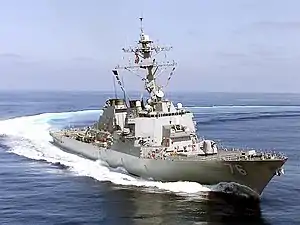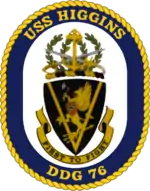USS Higgins
USS Higgins (DDG-76) is a United States Navy Arleigh Burke-class destroyer (flight II). Higgins, is the 26th ship of her class, the 15th of the class to be built by Bath Iron Works of Bath, Maine. Construction began on 14 November 1996 and she was launched and christened on 4 October 1997. She was commissioned at a ceremony in Port Everglades, Florida on 24 April 1999.
 USS Higgins in the Pacific Ocean | |
| History | |
|---|---|
| Name: | USS Higgins |
| Namesake: | William R. Higgins |
| Ordered: | 19 January 1993 |
| Builder: | Bath Iron Works, Bath, Maine |
| Laid down: | 14 November 1996 |
| Launched: | 4 October 1997 |
| Acquired: | 14 January 1999 |
| Commissioned: | 24 April 1999 |
| Homeport: | Naval Base San Diego |
| Motto: | First to Fight |
| Status: | in active service |
| Badge: |
 |
| General characteristics | |
| Class and type: | Arleigh Burke-class destroyer |
| Displacement: |
|
| Length: | 505 ft (154 m) |
| Beam: | 66 ft (20 m) |
| Draft: | 31 ft (9.4 m) |
| Propulsion: | 4 General Electric LM2500-30 gas turbines, two shafts, 100,000 total shaft horsepower (75 MW) |
| Speed: | >30 knots (56 km/h; 35 mph) |
| Range: |
|
| Complement: | |
| Sensors and processing systems: |
|
| Electronic warfare & decoys: |
|
| Armament: |
|
| Aircraft carried: | 1 SH-60 Sea Hawk helicopter can be embarked, no hangar |
Namesake
She is named for USMC Colonel William R. Higgins, who was captured, tortured and murdered in 1988 by Hezbollah, during a UN peacekeeping mission to Lebanon. In 1992 he was posthumously awarded the Presidential Citizens Medal, and two years later it was announced that a ship would be named in his honor.
Service history
She was built by Bath Iron Works in Bath, Maine. At her christening on 1 October 1997 and the vessel was christened by Robin L. Higgins, retired Lieutenant Colonel, USMC, wife of Colonel Higgins, as the ship's sponsor. "In the name of all that is good and right in the world - Semper Fi - Always Faithful - I christen thee HIGGINS". Commander James "Red" Smith was the ship's first commanding officer.
HIGGINS was the first ship off the coast for The Hainan Island incident that occurred on April 1, 2001, when a United States Navy EP-3E ARIES II signals intelligence aircraft and a People's Liberation Army Navy (PLAN) J-8II interceptor fighter jet collided in mid-air, resulting in an international dispute between the United States of America and the People's Republic of China (PRC) on her maiden deployment.
Upon returning to San Diego in April 2004, HIGGINS completed a safe and efficient ordnance offload and fuel transfer and headed into a 9-week Selected Restricted Availability. This time in the shipyard enhanced HIGGINS’ capabilities including the installation of the Tactical Tomahawk weapons system, the refurbishment of the Mk 45/5” Lightweight Gun Mount and Mk 41 Vertical Launch systems, and an enhanced Combat Systems suite.
December 2004 marked the beginning of a busy upcoming year for USS HIGGINS. HIGGINS became a member of the NIMITZ Carrier Strike Group, in the company of USS NIMITZ, USS PRINCETON, USS CHAFEE, and USS LOUISVILLE. In the three week Composite Unit Exercise that followed, HIGGINS stood out in all mission areas and, along with the other ships in the NIMITZ Strike Group, was now certified “surge ready” to deploy.
In February 2005, the ship conducted the Congressionally-mandated inspection by the Board of Inspection and Survey (INSURV). This complete material assessment of the ship was successfully completed and was highlighted by a one day underway demonstration which showcased HIGGINS’ high levels of combat readiness with near-perfect grades in nearly every category.
The next pre-deployment milestone consisted of HIGGINS’ ordnance onload at Naval Weapons Station Seal Beach. Once the ship was outfitted with its deployment load of ammunition, HIGGINS was once again underway with the NIMITZ Strike Group in March for its Joint Task Force Exercise. Coincident with that two week exercise, HIGGINS sent three teams to the recently instituted Non-Compliant Visit, Board, Search, and Seizure school and, as a result, became one of the first ships to deploy to the Fifth Fleet AOR with an organic non-compliant boarding capability, greatly enhancing its effectiveness in waging the Global War on Terrorism.
With only thirteen months since the previous deployment, HIGGINS commenced its second deployment on May 6, 2005 in company with the NIMITZ Strike Group. A brief stop at the North Island Naval Weapons Station provided HIGGINS with several new combat capabilities, particularly the new Tactical Tomahawk Cruise Missiles and the High Explosive Electronically Timed (HE-ET) and Kinetic Energy Electronically Timed (KE-ET) 5” projectiles. While the TACTOM missiles significantly enhance HIGGINS’ Strike warfare capabilities, the HE-ET and KE-ET rounds provide the ship more capable defense against an asymmetric surface threat.
In the second half of January 2006, HIGGINS conducted Mobility-Navigation and Seamanship (MOB-N and MOB-S) training while transiting to Puerto Vallarta for a three-day port visit. February and March saw various phases of the pre-deployment training cycle, including exercises or assessments in Anti-Terrorism and Force Protection, Engineering, Combat Systems Training Team capabilities, Supply and Medical Readiness, Damage Control, and Search and Rescue.
In April 2006, HIGGINS offloaded ammo in Seal Beach and completed a Mobility-Engineering (MOB-E) assessment in preparation for the ensuing Selected Restricted Availability (SRA) period, which brought with it many equipment upgrades that enhanced HIGGINS’ warfare capabilities.
In August 2006, HIGGINS returned to Naval Station San Diego from the shipyard and kicked off the pre-deployment “workups,” which included various inport scenarios involving Damage Control, Naval Surface Fire Support (NSFS), Ballistic Missile Defense (BMD), Undersea Warfare (USW), and Strike Warfare (STW). Later in the month, HIGGINS returned to Seal Beach to take on weapons required for the following year’s deployment.
The ship performed logistical support for United States Coast Guard helicopters undergoing relief operations for the 2010 Haiti earthquake.[2]
On 14 April 2018, she fired 23 Tomahawk missiles from a position in the north Persian Gulf as part of a bombing campaign in retaliation for the Syrian government's use of chemical weapons against people in Douma.[3]
On 27 May 2018, she, alongside the guided missile cruiser USS Antietam patrolled the 12-nautical-mile (22 km; 14 mi) zone surrounding the Paracel Islands in the South China Sea, which Vietnam has claimed as its territory, in an act to ensure freedom of navigation. Some say the patrol was in response to the deployment of H6-K bombers by the People's Liberation Army Air Force. That act was considered by the Pentagon to be an act of aggression, leading to rising tensions in the area.[4]
Deployments
Awards
- Coast Guard Meritorious Unit Commendation with Operational Distinguishing Device (1997-1999)
- Navy Unit Commendation (Jan-May 2003, Aug-Dec 2015)
- Navy Meritorious Unit Commendation (Dec 2000-Mar 2001) HARRY S TRUMAN BATTLE GROUP
- Battle "E" - (2003)
- Humanitarian Service Medal (14-25 Jan 2010) 2010 Haiti earthquake
- James F. Chezek Memorial Gunnery Award (1999, 2001)
Coat of arms

Shield
The shield has background of blue with a "V" cutting through the center. The griffin is shown in the "V" wielding an axe and a trident. The traditional Navy colors were chosen for the shield because dark blue, white and gold respectively represent the sea, integrity and excellence. The griffin, holding an axe and a trident, denotes valor and intelligence. The axe indicates her ability and readiness for engaging land based hostilities, while the trident symbolizes her modern weapon systems, giving her air combat and undersea engagement versatility. The "V" of the shield represents victory and the clover leaf is for good fortune.
Crest
The crest consists of an anchor with swords crossing in the middle, both surrounded by wreaths. The anchor is representative of the U.S. Navy. Two wreaths, one behind and one surrounding the anchor, symbolize the military and civilian honors awarded to Colonel Higgins for some unusual achievements. Crossed swords, a Naval officer's sword and a Marine Corps Mameluke, represent the long-standing tradition of Navy and Marine Corps cooperation in times of peace and war.
Motto
The motto is written on a scroll of gold that has a blue reverse side. The ships motto is "First to Fight". The motto is a reference to the honorable feats of Colonel Higgins and is part of The “Marines” Hymn.
Seal
The coat of arms in full color as in the blazon, upon a white background enclosed within a dark blue oval border edged on the outside with a gold rope and bearing the inscription "USS HIGGINS" at the top and "DDG 76" in the base all gold.
References
- "First U.S. vessel arrives at Port-au-Prince". NBC News. 13 January 2010. Retrieved 14 January 2010.
- Mehta, Aaron; Copp, Tara (14 April 2018). "Coalition launched 105 weapons against Syria, with none intercepted, DoD says". Military Times. Retrieved 14 April 2018.
- "China protests 'provocation' after US sends two warships near South China Sea islands". South China Morning Post. 28 May 2018.
This article includes information collected from the Naval Vessel Register, which, as a U.S. government publication, is in the public domain.
External links
| Wikimedia Commons has media related to USS Higgins (DDG-76). |
- Official site
- Naval Vessel Register – DDG-76
- USS Higgins Commanding Officer Relieved. Story Number: NNS070508-04. 8 May 2007
- http://www.history.navy.mil/shiphist/h/ddg76.htm - 1999 and 2000 Command History Reports for Higgins
